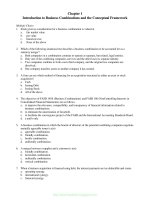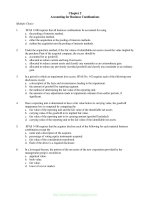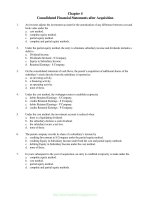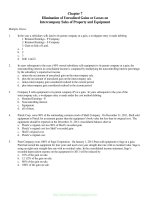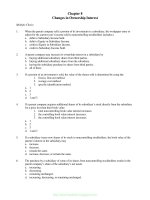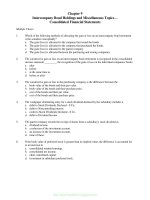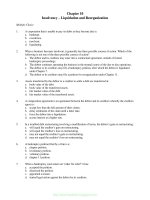Test bank with answers for advanced accounting 3e by jeter chapter 03
Bạn đang xem bản rút gọn của tài liệu. Xem và tải ngay bản đầy đủ của tài liệu tại đây (359.39 KB, 18 trang )
To
Todownload
downloadmore
moreslides,
slides,ebook,
ebook,solutions
solutionsand
andtest
testbank,
bank,visit
visit
Chapter 3
Consolidated Financial Statements—Date of Acquisition
Multiple Choice
1.
A majority-owned subsidiary that is in legal reorganization should normally be accounted for using
a. consolidated financial statements.
b. the equity method.
c. the market value method.
d. the cost method.
2.
Under the acquisition method, indirect costs relating to acquisitions should be
a. included in the investment cost.
b. expensed as incurred.
c. deducted from other contributed capital.
d. none of these.
3.
Eliminating entries are made to cancel the effects of intercompany transactions and are made on the
a. books of the parent company.
b. books of the subsidiary company.
c. workpaper only.
d. books of both the parent company and the subsidiary.
4.
One reason a parent company may pay an amount less than the book value of the subsidiary's stock
acquired is
a. an undervaluation of the subsidiary's assets.
b. the existence of unrecorded goodwill.
c. an overvaluation of the subsidiary's liabilities.
d. none of these.
5.
In a business combination accounted for as an acquisition, registration costs related to common
stock issued by the parent company are
a. expensed as incurred.
b. deducted from other contributed capital.
c. included in the investment cost.
d. deducted from the investment cost.
6.
On the consolidated balance sheet, consolidated stockholders' equity is
a. equal to the sum of the parent and subsidiary stockholders' equity.
b. greater than the parent's stockholders' equity.
c. less than the parent's stockholders' equity.
d. equal to the parent's stockholders' equity.
7.
Majority-owned subsidiaries should be excluded from the consolidated statements when
a. control does not rest with the majority owner.
b. the subsidiary operates under governmentally imposed uncertainty.
c. a foreign subsidiary is domiciled in a country with foreign exchange restrictions or controls.
d. any of these circumstances exist.
To
Todownload
downloadmore
moreslides,
slides,ebook,
ebook,solutions
solutionsand
andtest
testbank,
bank,visit
visit
3-2
Test Bank to accompany Jeter and Chaney Advanced Accounting 3rd Edition
8.
Under the economic entity concept, consolidated financial statements are intended primarily for the
benefit of the
a. stockholders of the parent company.
b. creditors of the parent company.
c. minority stockholders.
d. all of the above.
9.
Reasons a parent company may pay more than book value for the subsidiary company's stock
include all of the following except
a. the fair value of one of the subsidiary's assets may exceed its recorded value because of
appreciation.
b. the existence of unrecorded goodwill.
c. liabilities may be overvalued.
d. stockholders' equity may be undervalued.
10.
What is the method of presentation required by SFAS 160 of “non-controlling interest” on a
consolidated balance sheet?
a. As a deduction from goodwill from consolidation.
b. As a separate item within the long-term liabilities section.
c. As a part of stockholders' equity.
d. As a separate item between liabilities and stockholders' equity.
11.
Which of the following is a limitation of consolidated financial statements?
a. Consolidated statements provide no benefit for the stockholders and creditors of the parent
company.
b. Consolidated statements of highly diversified companies cannot be compared with industry
standards.
c. Consolidated statements are beneficial only when the consolidated companies operate within the
same industry.
d. Consolidated statements are beneficial only when the consolidated companies operate in
different industries.
12.
Pine Corp. owns 60% of Sage Corp.'s outstanding common stock. On May 1, 2011, Pine advanced
Sage $90,000 in cash, which was still outstanding at December 31, 2011. What portion of this
advance should be eliminated in the preparation of the December 31, 2011 consolidated balance
sheet?
a. $90,000.
b. $54,000.
c. $36,000.
d. $-0-.
To
Todownload
downloadmore
moreslides,
slides,ebook,
ebook,solutions
solutionsand
andtest
testbank,
bank,visit
visit
Chapter 3 Consolidated Financial Statements—Date of Acquisition
3-3
Use the following information for questions 13-15.
On January 1, 2011, Polk Company and Sigler Company had condensed balance sheets as follows:
Polk
Sigler
Current assets
$ 280,000
$ 80,000
Noncurrent assets
_360,000
__160,000
Total assets
$ 640,000
$240,000
Current liabilities
$ 120,000
$ 40,000
Long-term debt
200,000
-0Stockholders' equity
__120,000
200,000
Total liabilities & stockholders' equity
$ 640,000
$240,000
On January 2, 2011 Polk borrowed $240,000 and used the proceeds to purchase 90% of the outstanding
common stock of Sigler. This debt is payable in 10 equal annual principal payments, plus interest, starting
December 30, 2011. Any difference between book value and the value implied by the purchase price relates
to land.
On Polk's January 2, 2011 consolidated balance sheet,
13.
Noncurrent assets should be
a. $520,000.
b. $536,000.
c. $544,000.
d. $586,667.
14.
Current liabilities should be
a. $200,000.
b. $184,000.
c. $160,000.
d. $120,000.
15.
Noncurrent liabilities should be
a. $440,000.
b. $416,000.
c. $240,000.
d. $216,000.
16.
A newly acquired subsidiary has pre-existing goodwill on its books. The parent company’s
consolidated balance sheet will:
a. treat the goodwill the same as other intangible assets of the acquired company.
b. will always show the pre-existing goodwill of the subsidiary at its book value.
c. not show any value for the subsidiary’s pre-existing goodwill.
d. do an impairment test to see if any of it has been impaired.
17.
The Difference between Implied and Book Value account is:
a. an account necessary for the preparation of consolidated working papers.
b. used in allocating the amounts paid for recorded balance sheet accounts that are different than
their fair values.
c. the excess implied value assigned to goodwill.
d. the unamortized excess that cannot be assigned to any related balance sheet accounts
To
Todownload
downloadmore
moreslides,
slides,ebook,
ebook,solutions
solutionsand
andtest
testbank,
bank,visit
visit
3-4
Test Bank to accompany Jeter and Chaney Advanced Accounting 3rd Edition
18.
The main evidence of control for purposes of consolidated financial statements involves
a. possessing majority ownership
b. having decision-making ability that is not shared with others.
c. being the sole shareholder
d. having the parent company and the subsidiary participating in the same industry.
19.
In which of the following cases would consolidation be inappropriate?
a. The subsidiary is in bankruptcy.
b. Subsidiary's operations are dissimilar from those of the parent.
c. The parent owns 90 percent of the subsidiary's common stock, but all of the subsidiary's
nonvoting preferred stock is held by a single investor.
d. Subsidiary is foreign.
20.
Princeton Company acquired 75 percent of the common stock of Sheffield Corporation on
December 31, 2011. On the date of acquisition, Princeton held land with a book value of $150,000
and a fair value of $300,000; Sheffield held land with a book value of $100,000 and fair value of
$500,000. What amount would land be reported in the consolidated balance sheet prepared
immediately after the combination?
a. $650,000
b. $500,000
c. $550,000
d. $375,000
To
Todownload
downloadmore
moreslides,
slides,ebook,
ebook,solutions
solutionsand
andtest
testbank,
bank,visit
visit
Chapter 3 Consolidated Financial Statements—Date of Acquisition
3-5
Use the following information to answer questions 21 - 23.
On January 1, 2011, Pena Company and Shelby Company had condensed balanced sheets as follows:
Pena
Current assets
Noncurrent assets
Total assets
$ 210,000
270,000
$480,000
Current liabilities
Long-term debt
Stock holders' equity
Total liabilities & stockholders' equity
$
90,000
150,000
240,000
$ 480,000
Shelby
$ 60,000
120,000
$180,000
$ 30,000
-0150,000
$ 180,000
On January 2, 2011 Pena borrowed $180,000 and used the proceeds to purchase 90% of the outstanding
common stock of Shelby. This debt is payable in 10 equal annual principal payments, plus interest, starting
December 30, 2011. Any difference between book value and the value implied by the purchase price relates
to land.
On Pena's January 2, 2011 consolidated balance sheet,
21.
Noncurrent assets should be
a. $390,000.
b. $402,000.
c. $408,000.
d. $440,000.
22.
Current liabilities should be
a. $150,000.
b. $138,000.
c. $120,000.
d. $90,000.
23.
Noncurrent liabilities should be
a. $330,000.
b. $312,000.
c. $180,000.
d. $162,000.
24.
On January 1, 2011, Primer Corporation acquired 80 percent of Sutter Corporation's voting common stock.
Sutters's buildings and equipment had a book value of $300,000 and a fair value of $350,000 at the time of
acquisition. At what amount will Sutter’s buildings and equipment will be reported in the consolidated
statements ?
a. $350,000
b. $340,000
c. $280,000
d. $300,000
To
Todownload
downloadmore
moreslides,
slides,ebook,
ebook,solutions
solutionsand
andtest
testbank,
bank,visit
visit
3-6
Test Bank to accompany Jeter and Chaney Advanced Accounting 3rd Edition
Problems
3-1
On December 31, 2011, Page Company purchased 80% of the outstanding common stock of Snead
Company for cash. At the time of acquisition, Snead Company's balance sheet was as follows:
Current assets
Plant and equipment
Land
Total assets
$ 1,680,000
1,580,000
280,000
$3,540,000
Liabilities
Common stock, $10 par value
Other contributed capital
Retained earnings
Total
Treasury stock at cost, 5,000 shares
Total equities
$ 1,320,000
1,440,000
700,000
240,000
$3,700,000
160,000
$3,540,000
Required:
Prepare the elimination entry(s) required for the preparation of a consolidated balance sheet
workpaper on December 31, 2011, assuming the purchase price of the stock was $1,670,000. Any
difference between the value implied by the purchase price of the investment and the book value of
net assets acquired relates to subsidiary land.
3-2
P Company purchased 80% of the outstanding common stock of S Company on January 2, 2011, for
$380,000. Balance sheets for P Company and S Company immediately after the stock acquisition
were as follows:
Current assets
Investment in S Company
Plant and equipment (net)
Land
Current liabilities
Long-term notes payable
Common stock
Other contributed capital
Retained earnings
P Company
$ 166,000
380,000
560,000
40,000
$1,146,000
S Company
$ 96,000
-0224,000
120,000
$440,000
$ 120,000
-0480,000
244,000
302,000
$1,146,000
$ 44,000
36,000
160,000
64,000
136,000
$440,000
S Company owed P Company $16,000 on open account on the date of acquisition.
To
Todownload
downloadmore
moreslides,
slides,ebook,
ebook,solutions
solutionsand
andtest
testbank,
bank,visit
visit
Chapter 3 Consolidated Financial Statements—Date of Acquisition
3-7
Required:
Prepare a consolidated balance sheet for P and S Companies on the date of acquisition. Any
difference between the value implied by the purchase price of the investment and the book value of
net assets acquired relates to subsidiary land. The book values of S Company's other assets and
liabilities are equal to their fair values.
3-3
P Company acquired 54,000 shares of the common stock of S Company on January 1, 2011, for
$950,000 cash. The stockholders' equity section of S Company's balance sheet on that date was as
follows:
Common stock, $10 par value
Other contributed capital
Retained earnings
Total
$600,000
80,000
320,000
$1,000,000
On the date of acquisition, S Company owed P Company $10,000 on open account.
Required:
Present, in general journal form, the elimination entries for the preparation of a consolidated balance
sheet workpaper on January 1, 2011. The difference between the value implied by the purchase
price of the investment and the book value of the net assets acquired relates to subsidiary land.
3-4
On January 2, 2011, Potter Company acquired 90% of the outstanding common stock of Smiley
Company for $480,000 cash. Just before the acquisition, the balance sheets of the two companies
were as follows:
Cash
Accounts Receivable (net)
Inventory
Plant and Equipment (net)
Land
Total Assets
Potter
$ 650,000
360,000
290,000
970,000
150,000
$2,420,000
Smiley
$ 160,000
60,000
140,000
240,000
80,000
$680,000
Accounts Payable
Mortgage Payable
Common Stock, $2 par value
Other Contributed Capital
Retained Earnings
Total Equities
$ 260,000
180,000
1,000,000
520,000
460,000
$2,420,000
$ 120,000
100,000
170,000
50,000
240,000
$680,000
The fair values of Smiley's assets and liabilities are equal to their book values with the exception
of land.
To
Todownload
downloadmore
moreslides,
slides,ebook,
ebook,solutions
solutionsand
andtest
testbank,
bank,visit
visit
3-8
Test Bank to accompany Jeter and Chaney Advanced Accounting 3rd Edition
Required:
A. Prepare the journal entry necessary to record the purchase of Smiley's common stock.
B. Prepare a consolidated balance sheet at the date of acquisition.
3-5
P Corporation paid $420,000 for 70% of S Corporation’s $10 par common stock on December 31,
2011, when S Corporation’s stockholders’ equity was made up of $300,000 of Common Stock,
$90,000 of Other Contributed Capital and $60,000 of Retained Earnings. S’s identifiable assets and
liabilities reflected their fair values on December 31, 2011, except for S’s inventory which was
undervalued by $60,000 and their land which was undervalued by $25,000. Balance sheets for P
and S immediately after the business combination are presented in the partially completed workpaper below.
P
ASSETS
Cash
Accounts
receivable-net
Inventories
Land
Plant assetsnet
Investment in
S Corp.
Difference
between implied
and book value
Goodwill
Total Assets
EQUITIES
Current
liabilities
Capital stock
Additional paidin capital
Retained
earnings
Noncontrolling
interest
Total Equities
S
$40,000
$30,000
30,000
185,000
45,000
45,000
165,000
120,000
480,000
240,000
Eliminations
Debit
Credit
Noncontrolling
Interest
Consolidated
Balances
420,000
$1,200,000
$600,000
$170,000
600,000
$150,000
300,000
150,000
90,000
280,000
60,000
$1,200,000
$600,000
Required:
Complete the consolidated balance sheet workpaper for P Corporation and Subsidiary.
3-6
Prepare in general journal form the workpaper entries to eliminate Porter Company's investment in
Sewell Company in the preparation of a consolidated balance sheet at the date of acquisition for
each of the following independent cases:
To
Todownload
downloadmore
moreslides,
slides,ebook,
ebook,solutions
solutionsand
andtest
testbank,
bank,visit
visit
Chapter 3 Consolidated Financial Statements—Date of Acquisition
3-9
Sewell Company Equity Balances
Cash
Percent of
Stock Owned
Investment
Cost
Common
Stock
Other Contributed
Capital
Retained
Earnings
a.
90
$675,000
$450,000
$180,000
$75,000
b.
80
318,000
620,000
140,000
20,000
Any difference between book value of net assets acquired and the value implied by the purchase
price relates to subsidiary property, plant, and equipment except for case (b). In case (b) assume that
all book values and fair values are the same.
3-7
On December 31, 2011, Pryor Company purchased a controlling interest in Shelby Company for
$1,060,000. The consolidated balance sheet on December 31, 2011 reported noncontrolling interest
in Shelby Company of $265,000.
On the date of acquisition, the stockholders' equity section of Shelby Company's balance sheet was
as follows:
Common stock
Other contributed capital
Retained earnings
Total
$520,000
380,000
280,000
1,180,000
Required:
A. Compute the noncontrolling interest percentage on December 31, 2011.
B. Prepare the investment elimination entry made to prepare a consolidated balance sheet
workpaper. Any difference between book value and the value implied by the purchase price
relates to subsidiary land.
3-8
On January 1, 2011, Primer Company issued 1,500 of its $20 par value common shares with a fair
value of $50 per share in exchange for 2,000 outstanding common shares of Swartz Company in a
purchase transaction. Registration costs amounted to $1,700 paid in cash. Just prior to the
acquisition, the balance sheets of the two companies were as follows:
Cash
Accounts Receivable (net)
Inventory
Plant and Equipment (net)
Land
Total Assets
Accounts Payable
Notes Payable
Primer
Swartz
$ 73,000
95,000
58,000
95,000
26,000
$ 347,000
$13,000
19,000
25,000
43,000
20,000
$ 120,000
$ 66,000
82,000
16,000
21,000
To
Todownload
downloadmore
moreslides,
slides,ebook,
ebook,solutions
solutionsand
andtest
testbank,
bank,visit
visit
3-10 Test Bank to accompany Jeter and Chaney Advanced Accounting 3rd Edition
Common Stock, $20 par value
Other Contributed Capital
Retained Earnings
Total Liabilities and Equities
100,000
60,000
39,000
$ 347,000
40,000
24,000
19,000
$ 120,000
Any differences between the book value of equity and the value implied by the purchase price relates to
Land.
Required:
A. Prepare the journal entry on Primer’s books to record the exchange of stock.
B. Prepare a Computation and Allocation Schedule for the Difference between book value and value
implied by the purchase price.
C. Calculate the consolidated balance for each of the following accounts as of December 31, 2011:
1. Cash
2. Land
3. Common Stock
4. Other Contributed Capital
Short Answer
1. There are several reasons why a company would acquire a subsidiary’s voting common stock
rather than its net assets. Identify at least two advantages to acquiring a controlling interest in
the voting stock of another company rather than its assets.
2. A useful first step in the consolidating process is to prepare a Computation and Allocation of
Difference (CAD) Schedule. Identify the steps involved in preparing the CAD schedule.
Short Answer Questions from the Textbook
1. What are the advantages of acquiring the majority of the voting stock of another company rather than
acquiring all its voting stock?
2. What is the justification for preparing consolidated financial statements when, in fact, it is ap-parent that
the consolidated group is not a legal entity?
3. Why is it often necessary to prepare separate financial statements for each legal entity in a consolidated
group even though consolidated statements provide a better economic picture of the combined
activities?
4. What aspects of control must exist before a subsidiary is consolidated?
5. Why are consolidated work papers used in pre-paring consolidated financial statements?
6. Define noncontrolling (minority) interest. List three methods that might be used for reporting the
noncontrolling interest in a consolidated balance sheet, and state which is preferred under the SFAS No.
160[topic 810].
To
Todownload
downloadmore
moreslides,
slides,ebook,
ebook,solutions
solutionsand
andtest
testbank,
bank,visit
visit
Chapter 3 Consolidated Financial Statements—Date of Acquisition
3-11
7. Give several reasons why a parent company would be willing to pay more than book value for
subsidiary stock acquired.
8. What effect do subsidiary treasury stock holdings have at the time the subsidiary is acquired? How
should the treasury stock be treated on consolidated work papers?
9. What effect does a noncontrolling interest have on the amount of intercompany receivables and payables
eliminated on a consolidated balance sheet?
10 A.SFAS No. 109and SFAS No. 141R[ASC 740 and805] require that a deferred tax asset or liability
be recognized for likely differences between the reported values and tax bases of assets and liabilities
recognized in business combinations (for example, in exchanges that are nontaxable to the selling
shareholders). Does this decision change the amount of consolidated net income reported in years
subsequent to the business combination? Explain.
Business Ethics Question from the Textbook
Part I. You are working on the valuation of accounts receivable, and bad debt reserves for the
current year’s annual report. The CFO stops by and asks you to reduce the reserve by enough to
increase the current year’s EPS by 2 cents a share. The company’s policy has always been to use the
previous year’s actual bad debt percentage adjusted for a specific economic index. The CFO’s
suggested change would still be within acceptable GAAP. However, later, you learn that with the
increased EPS, the CFO would qualify for a significant bonus. What do you do and why?
Part II. Consider the following: Accounting firm KPMG created tax shelters called BLIPS, FLIP,
OPIS, and SOS that were based largely in the Cayman Islands and allowed wealthy clients (there
were 186) to create $5 billion in losses, which were then deducted from their income for IRS tax
purposes. BLIPS (Bond Linked Issue Premium Structures) had clients borrow from an offshore
bank for purposes of purchasing currency. The client would then sell the currency back to the lender
for a loss. However, the IRS contends the losses were phony and that there was never any risk to the
client in the deals. The IRS has indicted eight former KPMG partners and an outside lawyer alleging
that the transactions were shams, illegal methods for avoiding taxes. KPMG has agreed to pay
a$456 million fine, no longer to do tax shelters, and to cooperate with the government in its
prosecution of the nine individuals involved in the tax shelter scheme. Many argue that the courts
have not always held that such tax avoidance schemes show criminal intent because the tax laws
permit individuals to minimize taxes. However, the IRS argues that these shelters evidence intent
because of the lack of risk.
Question
In this case, the IRS contends that the losses generated by the tax shelters were phony and that the
clients never incurred any risk. Do tax avoidance schemes indicate criminal intent if the tax laws
permit individuals to minimize taxes? Justify your answer.
To
Todownload
downloadmore
moreslides,
slides,ebook,
ebook,solutions
solutionsand
andtest
testbank,
bank,visit
visit
3-12 Test Bank to accompany Jeter and Chaney Advanced Accounting 3rd Edition
ANSWER KEY
Multiple Choice
1. d
2. b
3. c
4. d
5. b
6. d
7. d
Problems
3-1
8.
9.
10.
11.
12.
13.
14.
d
d
c
b
a
d
b
15.
16.
17.
18.
19.
20.
21.
b
c
b
b
a
a
d
22. b
23. b
24. a
Common Stock – Snead
Other Contributed Capital – Snead
Retained Earnings – Snead
Investment in Snead Company
Treasury Stock - Snead
Difference Between Implied and Book Value
Noncontrolling Interest
1,440,000
700,000
240,000
1,670,000
160,000
106,000
444,000
Difference Between Implied and Book Value
Land
3-2
3-3
106,000
106,000
P COMPANY AND SUBSIDIARY
Consolidated Balance Sheet
January 2, 2011
Current assets
Plant and equipment (net)
Land ($160,000 + $115,000 excess cost)
Total
$246,000
784,000
275,000
$1,305,000
Current liabilities
Long-term notes payable
Common stock
Noncontrolling interest
Other contributed capital
Retained earnings
Total
$ 148,000
36,000
480,000
95,000
244,000
302,000
$1,305,000
Accounts Payable (to P)
Accounts Receivable (from S)
Common Stock - S
Other Contributed Capital - S
Retained Earnings - S
10,000
10,000
600,000
80,000
320,000
To
Todownload
downloadmore
moreslides,
slides,ebook,
ebook,solutions
solutionsand
andtest
testbank,
bank,visit
visit
Chapter 3 Consolidated Financial Statements—Date of Acquisition
Difference Between Implied and Book Value
Investment in S Company
Noncontrolling Interest
50,000
950,000
100,000
Land
50,000
Difference Between Implied and Book Value
3-4
A.
Investment in Smiley Company
Cash
B.
50,000
480,000
480,000
POTTER COMPANY AND SUBSIDIARY
Consolidated Balance Sheet
January 2, 2011
Assets
Cash (650,000 + 160,000 - $480,000)
Accounts Receivable
Inventory
Plant and Equipment (net)
Land ($150,000 + $80,000 + $73,333*)
Total Assets
Liabilities and Stockholders’ Equity
Accounts Payable
Mortgage Payable
Total liabilities
Noncontrolling Interest
($170,000 + $50,000 + $240,000 + 73,333) × .10
Common Stock
$1,000,000
Other Contributed Capital
520,000
Retained Earnings
460,000
Total Stockholders’ Equity
Total Liabilities and Stockholders’ Equity
$330,000
420,000
430,000
1,210,000
303,333
$2,693,333
$380,000
280,000
$660,000
$ 53,333
1,980,000
$2,693,333
* $480,000/.9 - ($170,000 + $50,000 + $240,000)
3-13
To
Todownload
downloadmore
moreslides,
slides,ebook,
ebook,solutions
solutionsand
andtest
testbank,
bank,visit
visit
3-14 Test Bank to accompany Jeter and Chaney Advanced Accounting 3rd Edition
3-5
P
ASSETS
Cash
Accounts
receivable-net
Inventories
Land
Plant assetsnet
Investment in
S Corp.
Difference
between
implied and
book value
Goodwill
Total Assets
EQUITIES
Current
liabilities
Capital stock
Additional
paid-in capital
Retained
earnings
Noncontrolling
interest
Total Equities
3-6
A.
B.
S
$40,000
$30,000
30,000
185,000
45,000
45,000
165,000
120,000
480,000
240,000
Eliminations
Debit
Credit
Noncontrolling
Interest
Consolidated
Balances
$70,000
75,000
410,000
190,000
(b) 60,000
(b) 25,000
720,000
420,000
(a) 420,000
(a) 150,000
(b) 65,000
(b) 150,000
$1,200,000
$600,000
65,000
$1,530,000
$170,000
600,000
$150,000
300,000
(a) 300,000
$320,000
600,000
150,000
90,000
(a) 90,000
150,000
280,000
60,000
(a) 60,000
280,000
$1,200,000
$600,000
$750,000
(a) 180,000
$750,000
Common Stock – Sewell
Other Contributed Capital – Sewell
Difference between Implied and Book Values
Retained Earnings – Sewell
Investment in Sewell
Noncontrolling Interest in Equity
450,000
180,000
45,000
75,000
Common Stock – Sewell
Other Contributed Capital – Sewell
Retained Earnings – Sewell
Investment in Sewell
Gain on Purchase of Business - Porter
Noncontrolling Interest in Equity
620,000
140,000
20,000
180,000
675,000
75,000
318,000
306,000
156,000
180,000
$1,530,000
To
Todownload
downloadmore
moreslides,
slides,ebook,
ebook,solutions
solutionsand
andtest
testbank,
bank,visit
visit
Chapter 3 Consolidated Financial Statements—Date of Acquisition
3-7
A.
265,000/(1,060,000 +265,000) = 20% Noncontrolling interest
B.
Common Stock – Shelby
Other Contributed Capital – Shelby
Retained Earnings – Shelby
Difference between Implied and Book Values
Investment in Shelby Company
Noncontrolling Interest in Equity
520,000
380,000
280,000
145,000
Investment in Swartz Company ($50 1,500)
Common Stock ($20 1,500)
Other Contributed Capital ($30 1,500)
75,000
3-15
1,060,000
265,000
3-8
A.
Other Contributed Capital
Cash
30,000
45,000
1,700
1,700
B. Computation and Allocation of Difference
Purchase price and implied value
Less: Book value of equity acquired
Difference between implied and book value
Land
Balance
* $40,000 + $24,000 + $19,000 = $83,000
Parent
Share
$75,000
83,000*
7,000
(7,000)
-0-
NonControlling
Share
0
0
0
(0)
-0-
Entire
Value
75,000
83,000
7,000
(7,000)
-0-
C.
Cash balance: 73,000 + 13,000 –1,700 = $84,300
Land balance: 26,000 + 20,000 + 7,000= $ 53,000
Common Stock balance: 100,000 + 30,000 = $130,000
Other Contributed Capital: 60,000 + 45,000 – 1,700 = $ 103,300
Short Answer
1. Reasons why a company would acquire a subsidiary rather than its net assets include the following:
a. Stock acquisition is relatively simple and avoids the often lengthy and difficult negotiations that
are required in a complete takeover.
b. Control of the subsidiary's operations can be accomplished with a much smaller investment.
c. The separate legal existence of the individual affiliates provides an element of protection of the
parent's assets from attachment by subsidiary creditors.
To
Todownload
downloadmore
moreslides,
slides,ebook,
ebook,solutions
solutionsand
andtest
testbank,
bank,visit
visit
3-16 Test Bank to accompany Jeter and Chaney Advanced Accounting 3rd Edition
2. Preparation of the Computation and Allocation of Difference Schedule involves the following
process:
a. Determine the percentage of stock acquired in the subsidiary.
b. Compute the implied value of the subsidiary by dividing the purchase price by the percentage
acquired.
c. Allocate any difference between the implied value and the book value of the subsidiary's equity
to adjust the underlying assets and/or liabilities of the acquired company.
Short Answer Questions from the Textbook Solutions
1. (1) Stock acquisition is greatly simplified by avoiding the lengthy negotiations required in an
exchange of stock for stock in a complete takeover.
(2) Effective control can be accomplished with more than 50% but less than all of the voting
stock of a subsidiary; thus the necessary investment is smaller.
(3) An individual affiliate’s legal existence provides a measure of protection of the parent’s
assets from attachment by creditors of the subsidiary.
2. The purpose of consolidated financial statements is to present, primarily for the benefit of the
shareholders and creditors of the parent company, the results of operations and the financial
position of a parent company and its subsidiaries essentially as if the group were a single
company with one or more branches or divisions. The presumption is that these consolidated
statements are more meaningful than separate statements and necessary for fair presentation.
Emphasis then is on substance rather than legal form, and the legal aspects of the separate
entities are therefore ignored in light of economic aspects.
3. Each legal entity must prepare financial statements for use by those who look to the legal entity
for analysis. Creditors of the subsidiary will use the separate statements in assessing the degree
of protection related to their claims. Noncontrolling shareholders, too, use these individual
statements in determining risk and the amounts available for dividends. Regulatory agencies are
concerned with the net resources and results of operations of the individual legal entities.
4. (1) Control should exist in fact, through ownership of more than 50% of the voting stock of the
subsidiary.
(2) The intent of control should be permanent. If there are current plans to dispose of a
subsidiary, then the entity should not be consolidated.
(3) Majority owners must have control. Such would not be the case if the subsidiary were in
bankruptcy or legal reorganization, or if the subsidiary were in a foreign country where
political forces were such that control by majority owners was significantly curtailed.
5. Consolidated workpapers are used as a tool to facilitate the preparation of consolidated
financial statements. Adjusting and eliminating entries are entered on the workpaper so that the
resulting consolidated data reflect the operations and financial position of two or more
companies under common control.
To
Todownload
downloadmore
moreslides,
slides,ebook,
ebook,solutions
solutionsand
andtest
testbank,
bank,visit
visit
Chapter 3 Consolidated Financial Statements—Date of Acquisition
3-17
6. Noncontrolling interest represents the equity in a partially owned subsidiary by those
shareholders who are not members in the affiliation and should be accounted and presented in
equity, separately from the parents’ shareholders equity. Alternative views have included:
presenting the noncontrolling interest as a liability from the perspective of the controlling
shareholders; presenting the noncontrolling interest between liabilities and shareholders’ equity
to acknowledge its hybrid status; presenting it as a contra-asset so that total assets reflect only
the parent’s share; and presenting it as a component of owners’ equity (the choice approved by
FASB in its most recent exposure drafts).
7. The fair, or current, value of one or more specific subsidiary assets may exceed its recorded
value, or specific liabilities may be overvalued. In either case, an acquiring company might be
willing to pay more than book value. Also, goodwill might exist in the form of above normal
earnings. Finally, the parent may be willing to pay a premium for the right to acquire control
and the related economic advantages gained.
8. The determination of the percentage interest acquired, as well as the total equity acquired, is
based on shares outstanding; thus, treasury shares must be excluded. The treasury stock account
should be eliminated by offsetting it against subsidiary stockholder equity accounts. The
accounts affected as well as the amounts involved will depend upon whether the cost or par
method is used to account for the treasury stock.
9. None. The full amount of all intercompany receivables and payables is eliminated without
regard to the percentage of control held by the parent.
10 A. The decision in SFAS No. 109 and SFAS No. 141R [topics 740 and 805] is primarily a
display issue and would only affect the calculation of consolidated net income if there were
changes in expected future tax rates that resulted in an adjustment to the balance of deferred tax
assets or deferred tax liabilities. Prior to SFAS No. 109 and SFAS No. 141R, purchased assets
and liabilities were displayed at their net of tax amounts and related figures for amortization
and depreciation were based on the net of tax amounts. With the adoption of SFAS No. 109
and SFAS No. 141R, assets and liabilities are displayed at fair values and the tax consequences
for differences between their assigned values and their tax bases are displayed separately as
deferred tax assets or deferred tax liabilities. Although the amounts shown for depreciation,
amortization and income tax expense are different under SFAS No. 109 and SFAS No. 141R,
absent a change in expected future tax rates, the amount of consolidated net income will be the
same.
ANSWERS TO BUSINESS ETHICS CASE
Part 1
Even though the suggested changes by the CFO lie within GAAP, the proposed changes will
unfairly increase the EPS of the company, misleading the common investors and other users. It
is evident that the CFO is doing it for his or her personal gain rather than for the transparency
of financial reporting. Thus, manipulating the reserve in this case comes under the heading of
To
Todownload
downloadmore
moreslides,
slides,ebook,
ebook,solutions
solutionsand
andtest
testbank,
bank,visit
visit
3-18 Test Bank to accompany Jeter and Chaney Advanced Accounting 3rd Edition
unethical behavior. Taking a stand in such a situation is a difficult and challenging test for an
employee who reports to the CFO.
Part 2
The tax laws permit individuals to minimize taxes by means that are within the law like using
tax deductions, changing one's tax status through incorporation, or setting up a charitable trust
or foundation. In the given case the losses reported were phony and the whole scheme was
fabricated to illegally benefit certain individuals; hence there appears to be a criminal intent in
the scheme. Although there is no reason to pay more tax than necessary, the lack of risk in these
types of shelters makes participation in such schemes of questionable ethics, at the best.
